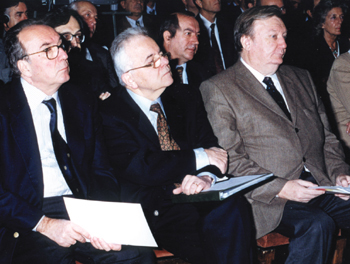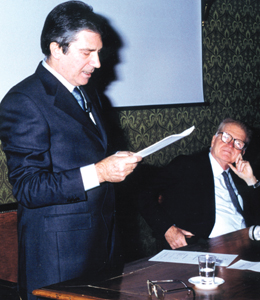The Italian Istituto Nazionale di Fisica Nucleare recently celebrated its 50th anniversary. Elisabetta Durante Romano looks at the origins of the institute, its subsequent development and its role in today’s major collaborations.
The Istituto Nazionale di Fisica Nucleare (INFN) is the direct heir to Enrico Fermi and Bruno Rossi’s eminent pre-Second World War schools of physics. Its purpose remains the same – to investigate the innermost structure of matter, a curiosity-driven research that over the years has led to a deep exploration of nature and that today motivates physicists to “draw a picture of the Big Bang”.

As Giorgio Salvini, former Italian minister for universities and research, recalled, the institute first wanted to equip itself with an accelerator – the most powerful at the time. “Fermi himself had suggested aiming high in energy…as it was new physics,” said Salvini. Fermi – the last truly universal physicist – also suggested building an electronic calculating machine, the first prototype of which at Pisa soon made possible the first commercial computer in Italy.
INFN president Enzo Iarocci recalled the history of the institute and some of its most important achievements: international success linked to the names of Rubbia, Cabibbo, Maiani and Zichichi. During the celebrations, these scientists described their view of the challenges of yesterday, today and tomorrow.
Nicola Cabibbo underlined the international extent of the research. “Discoveries [in this field] do not guarantee immediately profitable applications. Nevertheless, this kind of research stimulates great industrial interest, as experimental requirements continuously force technology to move on,” he said.
After recalling Fermi’s foresight and farsightedness, CERN director-general Luciano Maiani highlighted the INFN commitment to his laboratory and explained the expectations of the Large Hadron Collider (LHC) and other international projects.
For Antonino Zichichi, the major physics themes to be pursued in the coming years include matter-antimatter symmetry, quark-lepton flavour mixing, supersymmetry and dark matter – all of which are challenges that he views with both enthusiasm and optimism.

Nobel prizewinner Carlo Rubbia looked forward to a spectacular scenario. “The new and fundamental role of particle physics is far from being complete. Recent astronomical observations have demonstrated that 95% of the universe is made of dark and exotic matter and energy, still invisible and unknown: this necessarily implies the existence of new kinds of elementary particle and of elementary vacuum,” he said. Experiments with accelerators, such as the LHC, can offer important contributions, but other avenues of research must not be neglected and they can open the way to new and promising studies. Rubbia added: “It’s time to start a new and fascinating discovery game.”
Stimulating students
Included in the proceedings was a meeting entitled “Building the future” at which INFN scientific perspectives in various research fields were considered – from nuclear physics to elementary particle and astroparticle physics. Among those attending were high-school student winners of the INFN contest – From atoms to quarks: a trip to the heart of matter. The aim of the contest was to stimulate students’ curiosity in physics and its fundamental research.
The closing day, dedicated to human resources, traced INFN history through people, recalling the institute’s spirit and tradition, where intellectual authority rules and where human relationships are not submerged by hierarchy.
When INFN was born in 1951 it was paradoxically already 20 years old: its origins date back to Enrico Fermi and Bruno Rossi’s schools of physics and to 1930s research in nuclear physics and cosmic rays. In 1926 Fermi became professor of theoretical physics in Rome, working with a group of brilliant young students who became known as the “ragazzi di via Panisperna” (the via Panispera boys).
The milestone 1931 International Congress in Nuclear Physics held in Rome was the first platform to make the new Italian physics more visible to the external world and it opened the way to an extraordinary fertility of ideas and results by Fermi’s group in particular and within nuclear physics in general.
Soon, national political developments led to anti-Semitism and the disintegration of the group. On 6 December 1938 Fermi and his family left Italy for Stockholm, where he was awarded the Nobel Prize for Physics. From there he moved directly to the US and Rossi soon followed.
Despite enormous difficulties, research in Italy continued during the Second World War and it eventually led to major scientific and political achievements. It was time for both a national and an international relaunch of research via a general coordination of resources at both a local and a European level.
On 8 August 1951 INFN was created, with its first branches in Rome, Turin, Milan and Padua. Six months later, Edoardo Amaldi was designated general secretary of the institute and was also entrusted with the foundation of CERN.








